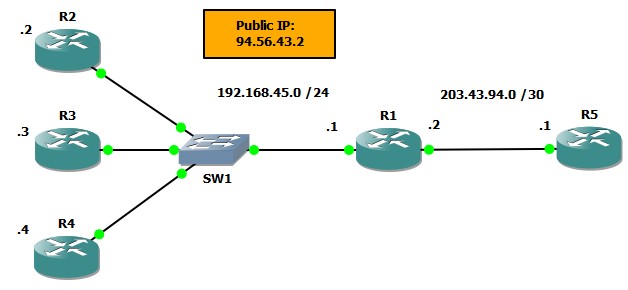In my previous blog entry, Multiple Public IP NATing to Multiple Hosts, I described how you can use “one to one” NATing to allocate one public IP address per internal host. This is a great solution for those who have multiple public IPs, however, these usually come at an added monthly cost.
An alternative to this method would be to run your services on different port numbers. For example, if you have three web servers, you could run one on port 80, the next on port 8080 and the last one on port 8081. However, some System Administrators do not like forcing their applications to run on non-standard ports and some applications may not even offer you the option.
So how do we fix this issue you ask? Rather than do the port change on the application(s) themselves, you can simply do it on the router itself. This is a great solution because the applications themselves do not need to be changed and you’ve got a central point of configuration for all of the port changes. Also, should you decide to invest in additional IP addresses later on down the track, you can migrate the server(s) to their new IP address(es) by simply changing a few lines of configuration.
Using the diagram below, I’ll describe how you can achieve this:
| Using the **“ip nat inside source static [tcp | udp]”** command, we can map port 23 (telnet) for each of the LAN hosts (192.168.45.2, 192.168.45.3 and 192.168.45.4) to different ports (23, 2300 and 2301 respectively). |
R1(config)#do sh run | inc ip nat inside source static
ip nat inside source static tcp 192.168.45.2 23 94.56.43.2 23 extendable
ip nat inside source static tcp 192.168.45.3 23 94.56.43.2 2300 extendable
ip nat inside source static tcp 192.168.45.4 23 94.56.43.2 2301 extendable
What this means is that if we try to telnet to:
- 94.56.43.2 on port 23, we’ll connect to 192.168.45.2
- 94.56.43.2 on port 2300, we’ll connect to 192.168.45.3
- 94.56.43.2 on port 2301, we’ll connect to 192.168.45.4
As mentioned above, the beauty of configuring the port changes on the internet router itself (R1), we don’t need to force telnet to run on different ports on the other hosts LAN hosts (R2, R3 and R4).
Let’s look at some examples. Here is R1’s NAT table before any traffic has been sent:
R1(config)#do sh ip nat trans
Pro Inside global Inside local Outside local Outside global
tcp 94.56.43.2:23 192.168.45.2:23 --- ---
tcp 94.56.43.2:2300 192.168.45.3:23 --- ---
tcp 94.56.43.2:2301 192.168.45.4:23 --- ---
Now I'll initiate some telnet sessions from **R1** to **94.56.43.2** and it's multiple ports. I'll start with port 23:
R5#telnet 94.56.43.2 23
Trying 94.56.43.2 ... Open
Now let’s take a look at the NAT translation table:
R1(config)#do sh ip nat trans
Pro Inside global Inside local Outside local Outside global
tcp 94.56.43.2:23 192.168.45.2:23 203.43.94.1:42931 203.43.94.1:42931
tcp 94.56.43.2:23 192.168.45.2:23 --- ---
tcp 94.56.43.2:2300 192.168.45.3:23 --- ---
tcp 94.56.43.2:2301 192.168.45.4:23 --- ---
Now I’ll try ports 2300 and 2301:
R5#telnet 94.56.43.2 2300
Trying 94.56.43.2, 2300 ... Open
R5#
R5#telnet 94.56.43.2 2301
Trying 94.56.43.2, 2301 ... Open
And now let’s take another look at the NAT translation table:
R1(config)#do sh ip nat trans
Pro Inside global Inside local Outside local Outside global
tcp 94.56.43.2:23 192.168.45.2:23 --- ---
tcp 94.56.43.2:2300 192.168.45.3:23 203.43.94.1:23292 203.43.94.1:23292
tcp 94.56.43.2:2300 192.168.45.3:23 --- ---
tcp 94.56.43.2:2301 192.168.45.4:23 203.43.94.1:49225 203.43.94.1:49225
tcp 94.56.43.2:2301 192.168.45.4:23 --- ---
As always, if you have any questions or have a topic that you would like me to discuss, please feel free to post a comment at the bottom of this blog entry, e-mail at will@oznetnerd.com, or drop me a message on Reddit (OzNetNerd).
Note: The opinions expressed in this blog are my own and not those of my employer.



Leave a comment